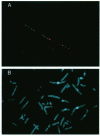Abstract
DiGeorge syndrome (DGS) is a developmental defect of some of the neural crest derivatives. Most DGS patients show haploinsufficiency due to interstitial deletions of the proximal long arm of chromosome 22. Deletions of 22q11 have also been reported with patients with the velocardio-facial syndrome and familial conotruncal heart defects. It has been suggested that the wide phenotype spectrum associated with 22q11 monosomy is a consequence of contiguous-gene deletions. We report the isolation of human cDNAs homologous to the Drosophila dishevelled (dsh) segment-polarity gene. Sequences homologous to the 3' UTR of these transcripts (DVL-22) were positioned within the DGS critical region and were found to be deleted in DGS patients. Human DVL mRNAs are expressed in several fetal and adult tissues, including the thymus and, at high levels, the heart. Two transcripts, 3.2 and 5kb, were detected, in northern blot analysis, with different expression patterns in the surveyed tissues when different cDNAs were used. The isolated cDNAs exhibit high amino acid homology with the mouse and Xenopus Dvl-1 gene, the only other vertebrate dsh homologues so far isolated. The pivotal role of dsh in fly development suggests an analogous key function in vertebrate embryogenesis of its homologue genes. Since DGS may be due to perturbation of differentiation mechanisms at decisive embryological stages, a Dsh-like gene in the small-region overlap (SRO) might be a candidate for the pathogenesis of this disorder.
Full text
PDF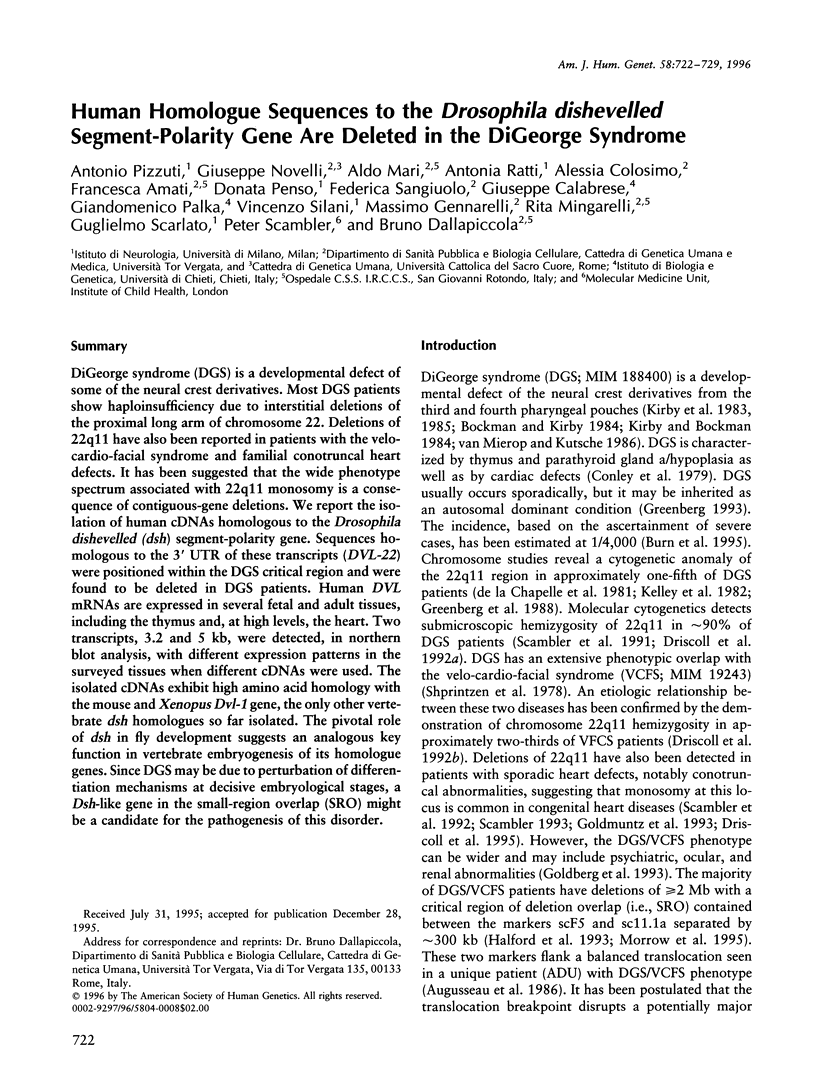
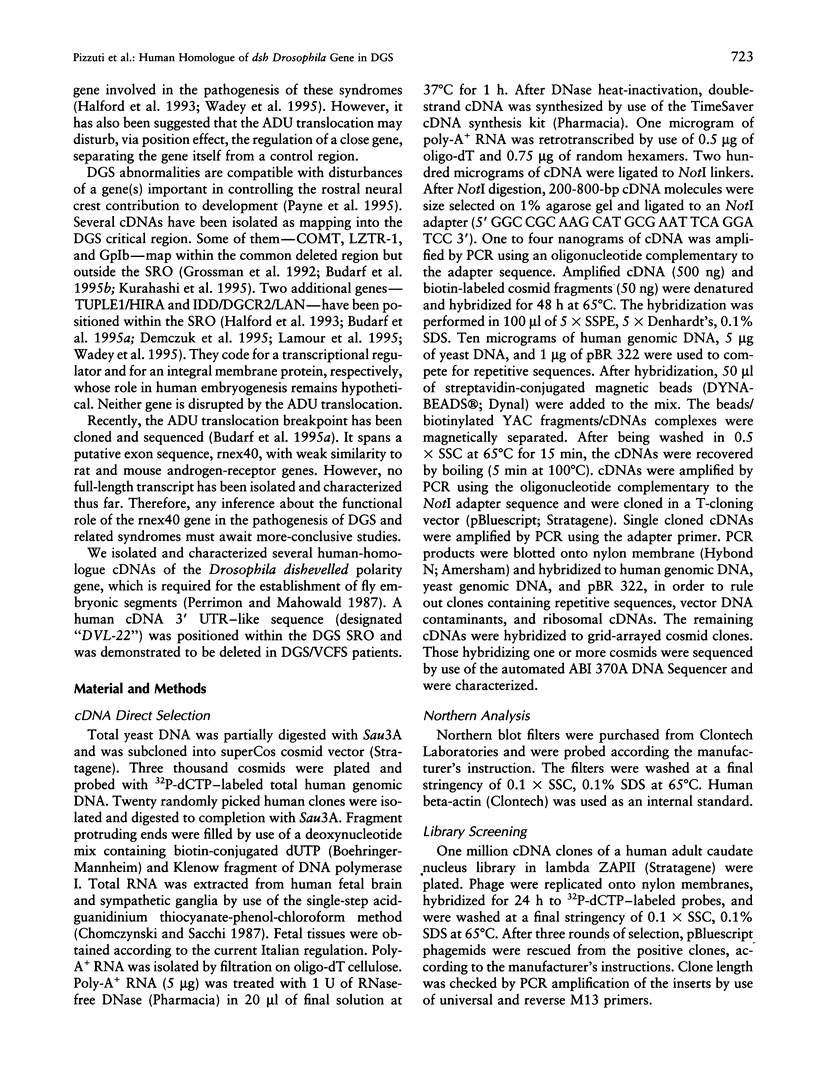
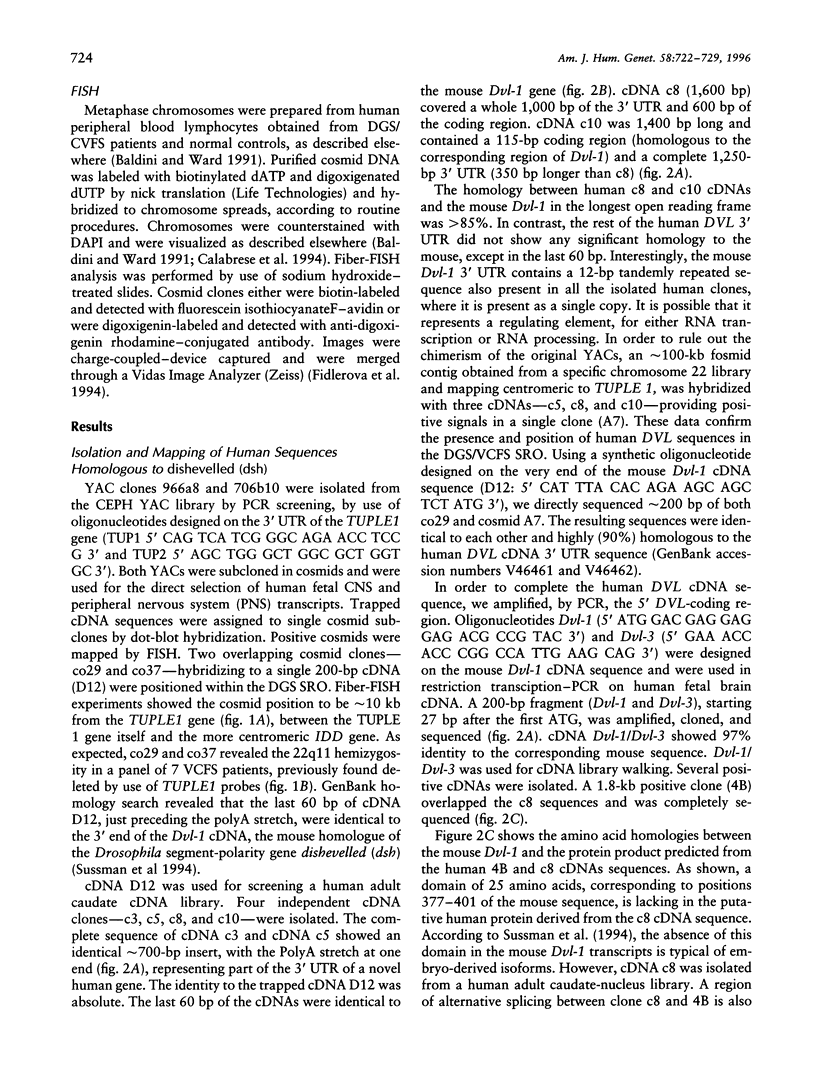
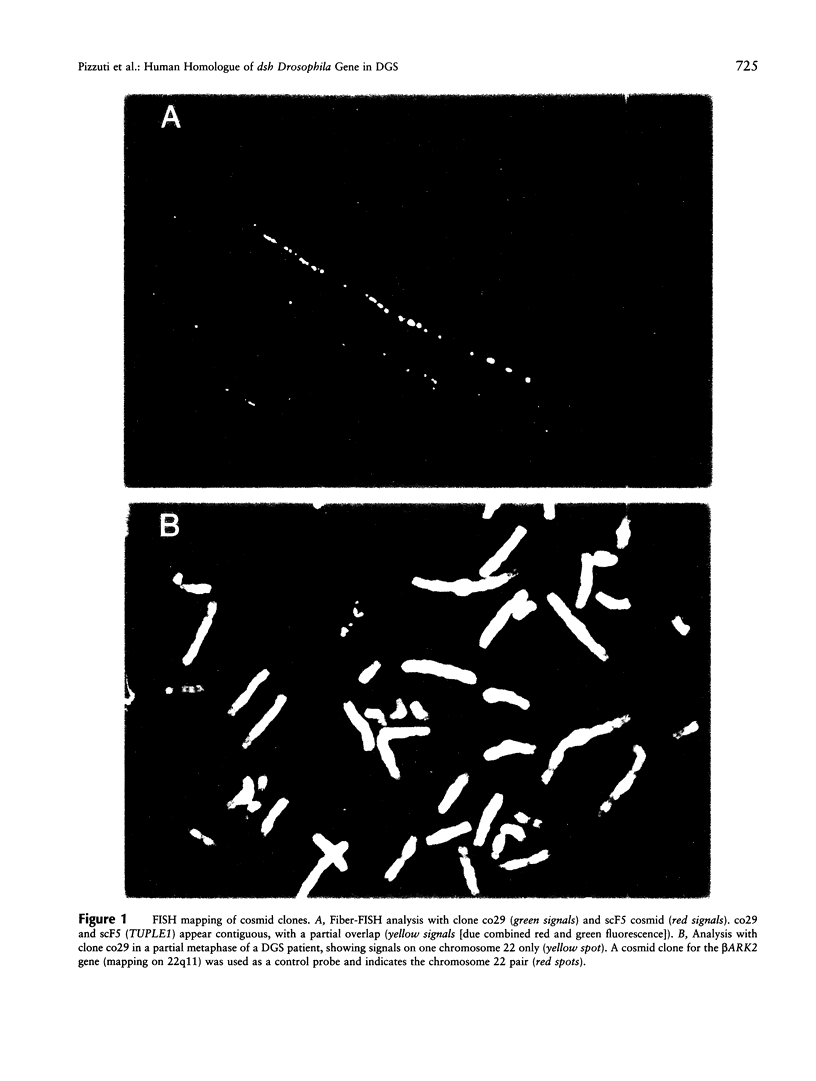
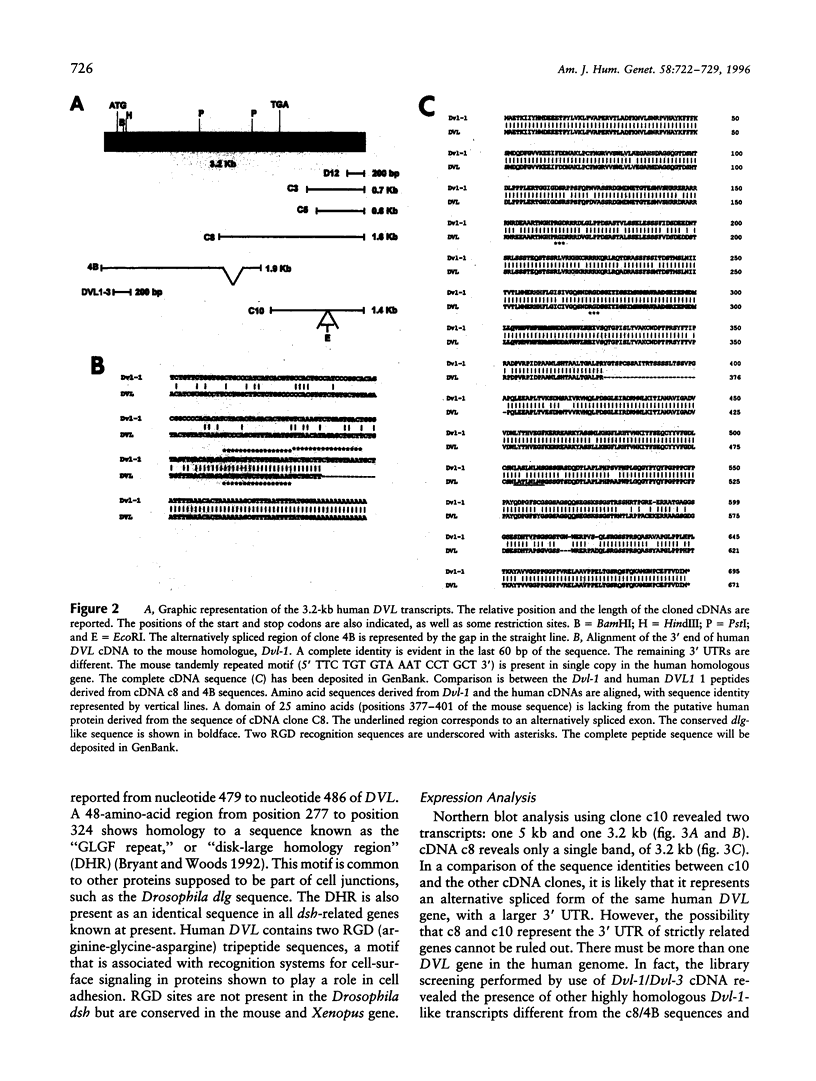
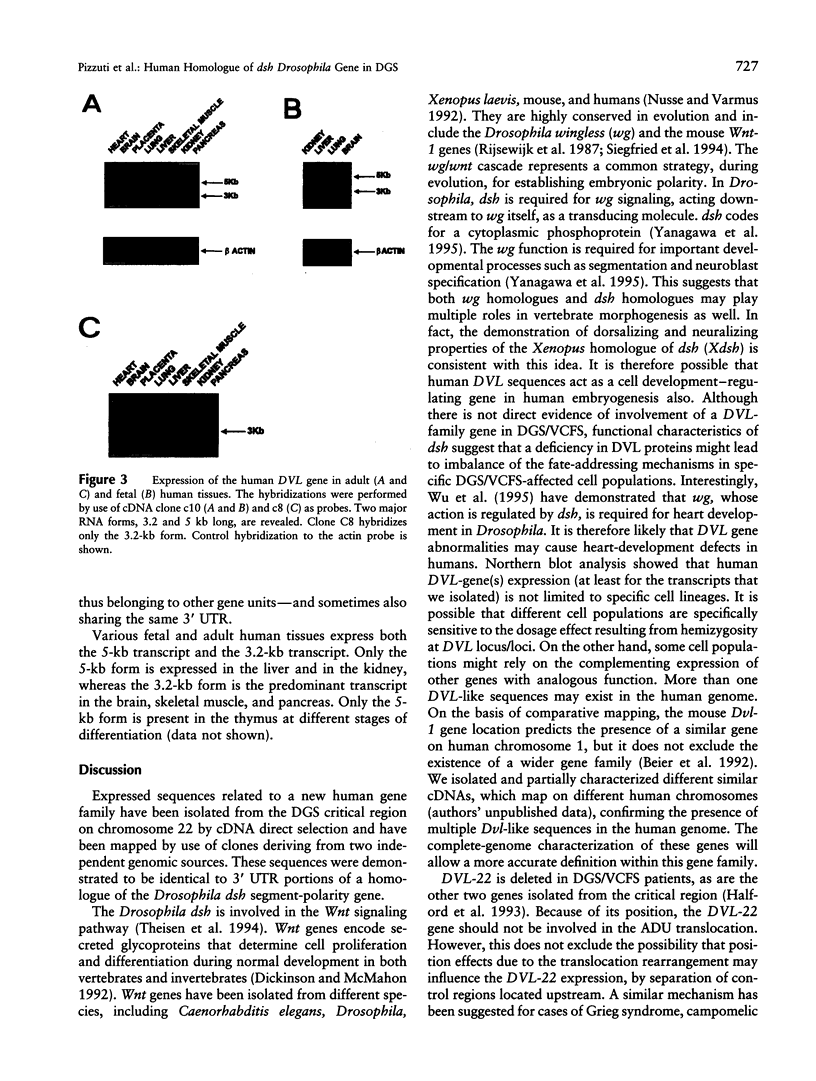
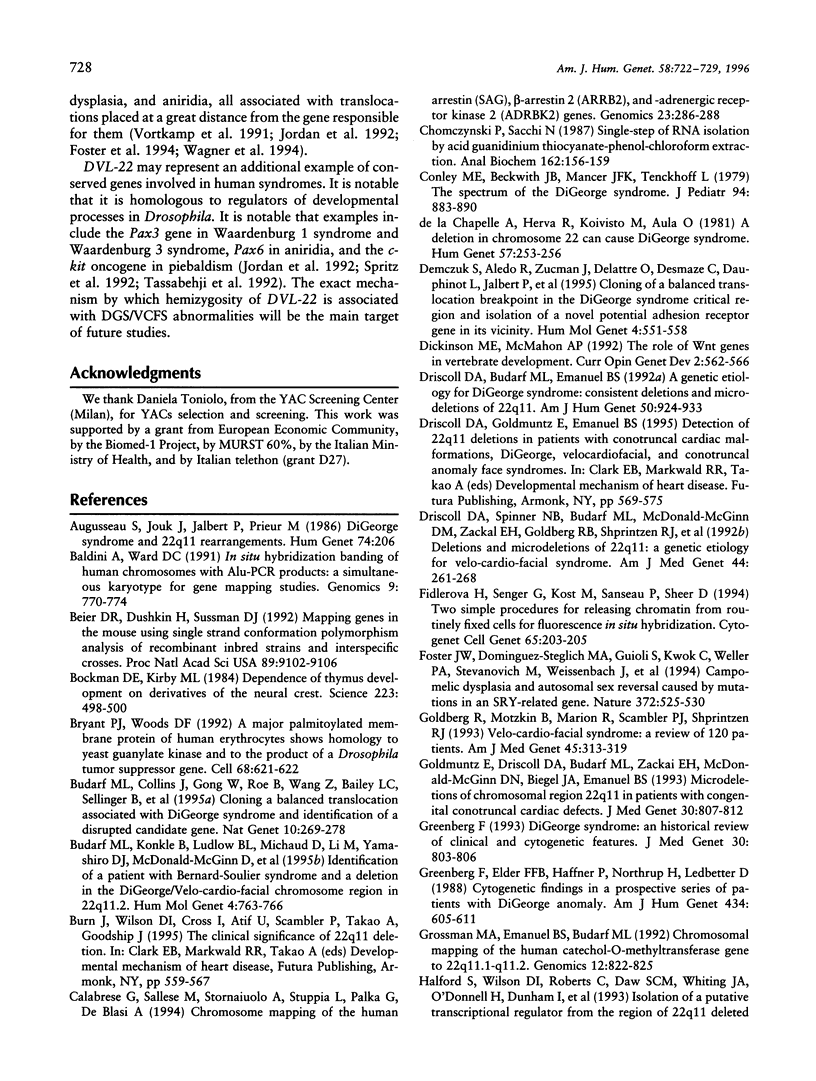
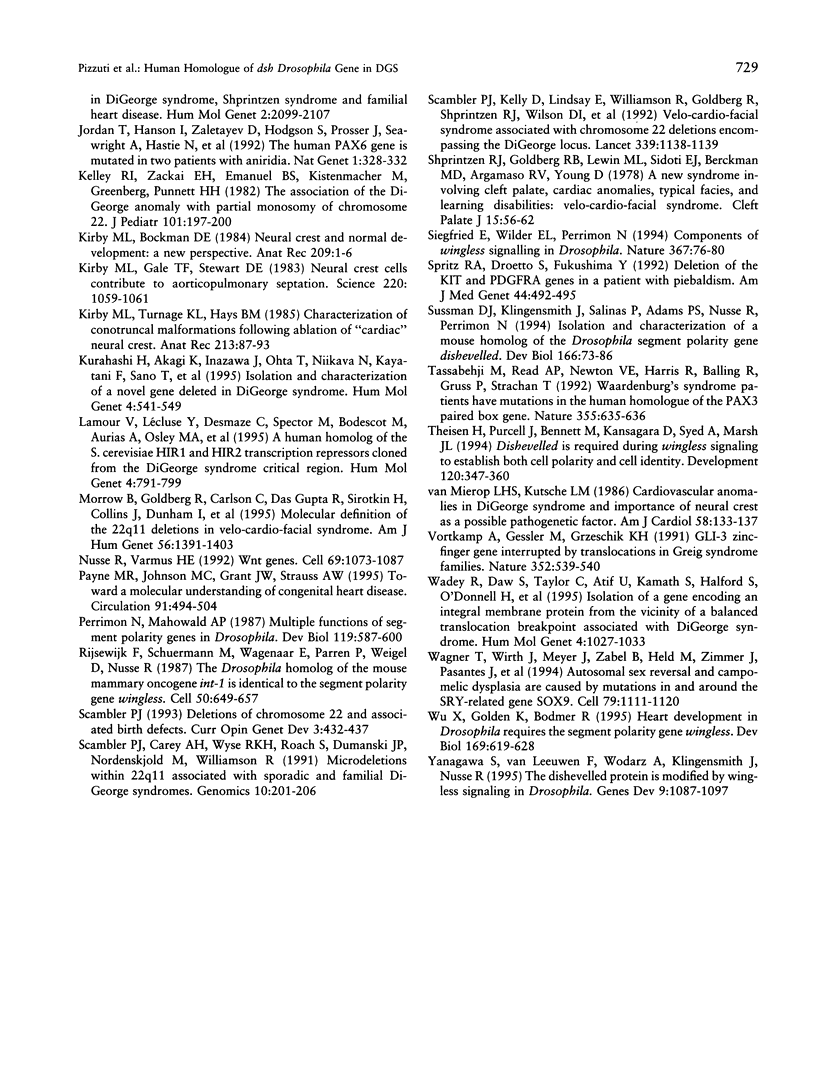
Images in this article
Selected References
These references are in PubMed. This may not be the complete list of references from this article.
- Augusseau S., Jouk S., Jalbert P., Prieur M. DiGeorge syndrome and 22q11 rearrangements. Hum Genet. 1986 Oct;74(2):206–206. doi: 10.1007/BF00282098. [DOI] [PubMed] [Google Scholar]
- Baldini A., Ward D. C. In situ hybridization banding of human chromosomes with Alu-PCR products: a simultaneous karyotype for gene mapping studies. Genomics. 1991 Apr;9(4):770–774. doi: 10.1016/0888-7543(91)90374-n. [DOI] [PubMed] [Google Scholar]
- Beier D. R., Dushkin H., Sussman D. J. Mapping genes in the mouse using single-strand conformation polymorphism analysis of recombinant inbred strains and interspecific crosses. Proc Natl Acad Sci U S A. 1992 Oct 1;89(19):9102–9106. doi: 10.1073/pnas.89.19.9102. [DOI] [PMC free article] [PubMed] [Google Scholar]
- Bockman D. E., Kirby M. L. Dependence of thymus development on derivatives of the neural crest. Science. 1984 Feb 3;223(4635):498–500. doi: 10.1126/science.6606851. [DOI] [PubMed] [Google Scholar]
- Bryant P. J., Woods D. F. A major palmitoylated membrane protein of human erythrocytes shows homology to yeast guanylate kinase and to the product of a Drosophila tumor suppressor gene. Cell. 1992 Feb 21;68(4):621–622. doi: 10.1016/0092-8674(92)90136-z. [DOI] [PubMed] [Google Scholar]
- Budarf M. L., Collins J., Gong W., Roe B., Wang Z., Bailey L. C., Sellinger B., Michaud D., Driscoll D. A., Emanuel B. S. Cloning a balanced translocation associated with DiGeorge syndrome and identification of a disrupted candidate gene. Nat Genet. 1995 Jul;10(3):269–278. doi: 10.1038/ng0795-269. [DOI] [PubMed] [Google Scholar]
- Budarf M. L., Konkle B. A., Ludlow L. B., Michaud D., Li M., Yamashiro D. J., McDonald-McGinn D., Zackai E. H., Driscoll D. A. Identification of a patient with Bernard-Soulier syndrome and a deletion in the DiGeorge/velo-cardio-facial chromosomal region in 22q11.2. Hum Mol Genet. 1995 Apr;4(4):763–766. doi: 10.1093/hmg/4.4.763. [DOI] [PubMed] [Google Scholar]
- Calabrese G., Sallese M., Stornaiuolo A., Stuppia L., Palka G., De Blasi A. Chromosome mapping of the human arrestin (SAG), beta-arrestin 2 (ARRB2), and beta-adrenergic receptor kinase 2 (ADRBK2) genes. Genomics. 1994 Sep 1;23(1):286–288. doi: 10.1006/geno.1994.1497. [DOI] [PubMed] [Google Scholar]
- Chomczynski P., Sacchi N. Single-step method of RNA isolation by acid guanidinium thiocyanate-phenol-chloroform extraction. Anal Biochem. 1987 Apr;162(1):156–159. doi: 10.1006/abio.1987.9999. [DOI] [PubMed] [Google Scholar]
- Conley M. E., Beckwith J. B., Mancer J. F., Tenckhoff L. The spectrum of the DiGeorge syndrome. J Pediatr. 1979 Jun;94(6):883–890. doi: 10.1016/s0022-3476(79)80207-3. [DOI] [PubMed] [Google Scholar]
- Demczuk S., Aledo R., Zucman J., Delattre O., Desmaze C., Dauphinot L., Jalbert P., Rouleau G. A., Thomas G., Aurias A. Cloning of a balanced translocation breakpoint in the DiGeorge syndrome critical region and isolation of a novel potential adhesion receptor gene in its vicinity. Hum Mol Genet. 1995 Apr;4(4):551–558. doi: 10.1093/hmg/4.4.551. [DOI] [PubMed] [Google Scholar]
- Dickinson M. E., McMahon A. P. The role of Wnt genes in vertebrate development. Curr Opin Genet Dev. 1992 Aug;2(4):562–566. doi: 10.1016/s0959-437x(05)80172-8. [DOI] [PubMed] [Google Scholar]
- Driscoll D. A., Budarf M. L., Emanuel B. S. A genetic etiology for DiGeorge syndrome: consistent deletions and microdeletions of 22q11. Am J Hum Genet. 1992 May;50(5):924–933. [PMC free article] [PubMed] [Google Scholar]
- Driscoll D. A., Spinner N. B., Budarf M. L., McDonald-McGinn D. M., Zackai E. H., Goldberg R. B., Shprintzen R. J., Saal H. M., Zonana J., Jones M. C. Deletions and microdeletions of 22q11.2 in velo-cardio-facial syndrome. Am J Med Genet. 1992 Sep 15;44(2):261–268. doi: 10.1002/ajmg.1320440237. [DOI] [PubMed] [Google Scholar]
- Fidlerová H., Senger G., Kost M., Sanseau P., Sheer D. Two simple procedures for releasing chromatin from routinely fixed cells for fluorescence in situ hybridization. Cytogenet Cell Genet. 1994;65(3):203–205. doi: 10.1159/000133632. [DOI] [PubMed] [Google Scholar]
- Foster J. W., Dominguez-Steglich M. A., Guioli S., Kwok C., Weller P. A., Stevanović M., Weissenbach J., Mansour S., Young I. D., Goodfellow P. N. Campomelic dysplasia and autosomal sex reversal caused by mutations in an SRY-related gene. Nature. 1994 Dec 8;372(6506):525–530. doi: 10.1038/372525a0. [DOI] [PubMed] [Google Scholar]
- Goldberg R., Motzkin B., Marion R., Scambler P. J., Shprintzen R. J. Velo-cardio-facial syndrome: a review of 120 patients. Am J Med Genet. 1993 Feb 1;45(3):313–319. doi: 10.1002/ajmg.1320450307. [DOI] [PubMed] [Google Scholar]
- Goldmuntz E., Driscoll D., Budarf M. L., Zackai E. H., McDonald-McGinn D. M., Biegel J. A., Emanuel B. S. Microdeletions of chromosomal region 22q11 in patients with congenital conotruncal cardiac defects. J Med Genet. 1993 Oct;30(10):807–812. doi: 10.1136/jmg.30.10.807. [DOI] [PMC free article] [PubMed] [Google Scholar]
- Greenberg F. DiGeorge syndrome: an historical review of clinical and cytogenetic features. J Med Genet. 1993 Oct;30(10):803–806. doi: 10.1136/jmg.30.10.803. [DOI] [PMC free article] [PubMed] [Google Scholar]
- Greenberg F., Elder F. F., Haffner P., Northrup H., Ledbetter D. H. Cytogenetic findings in a prospective series of patients with DiGeorge anomaly. Am J Hum Genet. 1988 Nov;43(5):605–611. [PMC free article] [PubMed] [Google Scholar]
- Grossman M. H., Emanuel B. S., Budarf M. L. Chromosomal mapping of the human catechol-O-methyltransferase gene to 22q11.1----q11.2. Genomics. 1992 Apr;12(4):822–825. doi: 10.1016/0888-7543(92)90316-k. [DOI] [PubMed] [Google Scholar]
- Halford S., Wadey R., Roberts C., Daw S. C., Whiting J. A., O'Donnell H., Dunham I., Bentley D., Lindsay E., Baldini A. Isolation of a putative transcriptional regulator from the region of 22q11 deleted in DiGeorge syndrome, Shprintzen syndrome and familial congenital heart disease. Hum Mol Genet. 1993 Dec;2(12):2099–2107. doi: 10.1093/hmg/2.12.2099. [DOI] [PubMed] [Google Scholar]
- Jordan T., Hanson I., Zaletayev D., Hodgson S., Prosser J., Seawright A., Hastie N., van Heyningen V. The human PAX6 gene is mutated in two patients with aniridia. Nat Genet. 1992 Aug;1(5):328–332. doi: 10.1038/ng0892-328. [DOI] [PubMed] [Google Scholar]
- Kelley R. I., Zackai E. H., Emanuel B. S., Kistenmacher M., Greenberg F., Punnett H. H. The association of the DiGeorge anomalad with partial monosomy of chromosome 22. J Pediatr. 1982 Aug;101(2):197–200. doi: 10.1016/s0022-3476(82)80116-9. [DOI] [PubMed] [Google Scholar]
- Kirby M. L., Bockman D. E. Neural crest and normal development: a new perspective. Anat Rec. 1984 May;209(1):1–6. doi: 10.1002/ar.1092090102. [DOI] [PubMed] [Google Scholar]
- Kirby M. L., Gale T. F., Stewart D. E. Neural crest cells contribute to normal aorticopulmonary septation. Science. 1983 Jun 3;220(4601):1059–1061. doi: 10.1126/science.6844926. [DOI] [PubMed] [Google Scholar]
- Kirby M. L., Turnage K. L., 3rd, Hays B. M. Characterization of conotruncal malformations following ablation of "cardiac" neural crest. Anat Rec. 1985 Sep;213(1):87–93. doi: 10.1002/ar.1092130112. [DOI] [PubMed] [Google Scholar]
- Kurahashi H., Akagi K., Inazawa J., Ohta T., Niikawa N., Kayatani F., Sano T., Okada S., Nishisho I. Isolation and characterization of a novel gene deleted in DiGeorge syndrome. Hum Mol Genet. 1995 Apr;4(4):541–549. doi: 10.1093/hmg/4.4.541. [DOI] [PubMed] [Google Scholar]
- Lamour V., Lécluse Y., Desmaze C., Spector M., Bodescot M., Aurias A., Osley M. A., Lipinski M. A human homolog of the S. cerevisiae HIR1 and HIR2 transcriptional repressors cloned from the DiGeorge syndrome critical region. Hum Mol Genet. 1995 May;4(5):791–799. doi: 10.1093/hmg/4.5.791. [DOI] [PubMed] [Google Scholar]
- Morrow B., Goldberg R., Carlson C., Das Gupta R., Sirotkin H., Collins J., Dunham I., O'Donnell H., Scambler P., Shprintzen R. Molecular definition of the 22q11 deletions in velo-cardio-facial syndrome. Am J Hum Genet. 1995 Jun;56(6):1391–1403. [PMC free article] [PubMed] [Google Scholar]
- Nusse R., Varmus H. E. Wnt genes. Cell. 1992 Jun 26;69(7):1073–1087. doi: 10.1016/0092-8674(92)90630-u. [DOI] [PubMed] [Google Scholar]
- Payne R. M., Johnson M. C., Grant J. W., Strauss A. W. Toward a molecular understanding of congenital heart disease. Circulation. 1995 Jan 15;91(2):494–504. doi: 10.1161/01.cir.91.2.494. [DOI] [PubMed] [Google Scholar]
- Perrimon N., Mahowald A. P. Multiple functions of segment polarity genes in Drosophila. Dev Biol. 1987 Feb;119(2):587–600. doi: 10.1016/0012-1606(87)90061-3. [DOI] [PubMed] [Google Scholar]
- Rijsewijk F., Schuermann M., Wagenaar E., Parren P., Weigel D., Nusse R. The Drosophila homolog of the mouse mammary oncogene int-1 is identical to the segment polarity gene wingless. Cell. 1987 Aug 14;50(4):649–657. doi: 10.1016/0092-8674(87)90038-9. [DOI] [PubMed] [Google Scholar]
- Scambler P. J., Carey A. H., Wyse R. K., Roach S., Dumanski J. P., Nordenskjold M., Williamson R. Microdeletions within 22q11 associated with sporadic and familial DiGeorge syndrome. Genomics. 1991 May;10(1):201–206. doi: 10.1016/0888-7543(91)90501-5. [DOI] [PubMed] [Google Scholar]
- Scambler P. J. Deletions of human chromosome 22 and associated birth defects. Curr Opin Genet Dev. 1993 Jun;3(3):432–437. doi: 10.1016/0959-437x(93)90117-8. [DOI] [PubMed] [Google Scholar]
- Scambler P. J., Kelly D., Lindsay E., Williamson R., Goldberg R., Shprintzen R., Wilson D. I., Goodship J. A., Cross I. E., Burn J. Velo-cardio-facial syndrome associated with chromosome 22 deletions encompassing the DiGeorge locus. Lancet. 1992 May 9;339(8802):1138–1139. doi: 10.1016/0140-6736(92)90734-k. [DOI] [PubMed] [Google Scholar]
- Shprintzen R. J., Goldberg R. B., Lewin M. L., Sidoti E. J., Berkman M. D., Argamaso R. V., Young D. A new syndrome involving cleft palate, cardiac anomalies, typical facies, and learning disabilities: velo-cardio-facial syndrome. Cleft Palate J. 1978 Jan;15(1):56–62. [PubMed] [Google Scholar]
- Siegfried E., Wilder E. L., Perrimon N. Components of wingless signalling in Drosophila. Nature. 1994 Jan 6;367(6458):76–80. doi: 10.1038/367076a0. [DOI] [PubMed] [Google Scholar]
- Spritz R. A., Droetto S., Fukushima Y. Deletion of the KIT and PDGFRA genes in a patient with piebaldism. Am J Med Genet. 1992 Nov 1;44(4):492–495. doi: 10.1002/ajmg.1320440422. [DOI] [PubMed] [Google Scholar]
- Sussman D. J., Klingensmith J., Salinas P., Adams P. S., Nusse R., Perrimon N. Isolation and characterization of a mouse homolog of the Drosophila segment polarity gene dishevelled. Dev Biol. 1994 Nov;166(1):73–86. doi: 10.1006/dbio.1994.1297. [DOI] [PubMed] [Google Scholar]
- Tassabehji M., Read A. P., Newton V. E., Harris R., Balling R., Gruss P., Strachan T. Waardenburg's syndrome patients have mutations in the human homologue of the Pax-3 paired box gene. Nature. 1992 Feb 13;355(6361):635–636. doi: 10.1038/355635a0. [DOI] [PubMed] [Google Scholar]
- Theisen H., Purcell J., Bennett M., Kansagara D., Syed A., Marsh J. L. dishevelled is required during wingless signaling to establish both cell polarity and cell identity. Development. 1994 Feb;120(2):347–360. doi: 10.1242/dev.120.2.347. [DOI] [PubMed] [Google Scholar]
- Van Mierop L. H., Kutsche L. M. Cardiovascular anomalies in DiGeorge syndrome and importance of neural crest as a possible pathogenetic factor. Am J Cardiol. 1986 Jul 1;58(1):133–137. doi: 10.1016/0002-9149(86)90256-0. [DOI] [PubMed] [Google Scholar]
- Vortkamp A., Gessler M., Grzeschik K. H. GLI3 zinc-finger gene interrupted by translocations in Greig syndrome families. Nature. 1991 Aug 8;352(6335):539–540. doi: 10.1038/352539a0. [DOI] [PubMed] [Google Scholar]
- Wadey R., Daw S., Taylor C., Atif U., Kamath S., Halford S., O'Donnell H., Wilson D., Goodship J., Burn J. Isolation of a gene encoding an integral membrane protein from the vicinity of a balanced translocation breakpoint associated with DiGeorge syndrome. Hum Mol Genet. 1995 Jun;4(6):1027–1033. doi: 10.1093/hmg/4.6.1027. [DOI] [PubMed] [Google Scholar]
- Wagner T., Wirth J., Meyer J., Zabel B., Held M., Zimmer J., Pasantes J., Bricarelli F. D., Keutel J., Hustert E. Autosomal sex reversal and campomelic dysplasia are caused by mutations in and around the SRY-related gene SOX9. Cell. 1994 Dec 16;79(6):1111–1120. doi: 10.1016/0092-8674(94)90041-8. [DOI] [PubMed] [Google Scholar]
- Wu X., Golden K., Bodmer R. Heart development in Drosophila requires the segment polarity gene wingless. Dev Biol. 1995 Jun;169(2):619–628. doi: 10.1006/dbio.1995.1174. [DOI] [PubMed] [Google Scholar]
- Yanagawa S., van Leeuwen F., Wodarz A., Klingensmith J., Nusse R. The dishevelled protein is modified by wingless signaling in Drosophila. Genes Dev. 1995 May 1;9(9):1087–1097. doi: 10.1101/gad.9.9.1087. [DOI] [PubMed] [Google Scholar]
- de la Chapelle A., Herva R., Koivisto M., Aula P. A deletion in chromosome 22 can cause DiGeorge syndrome. Hum Genet. 1981;57(3):253–256. doi: 10.1007/BF00278938. [DOI] [PubMed] [Google Scholar]



